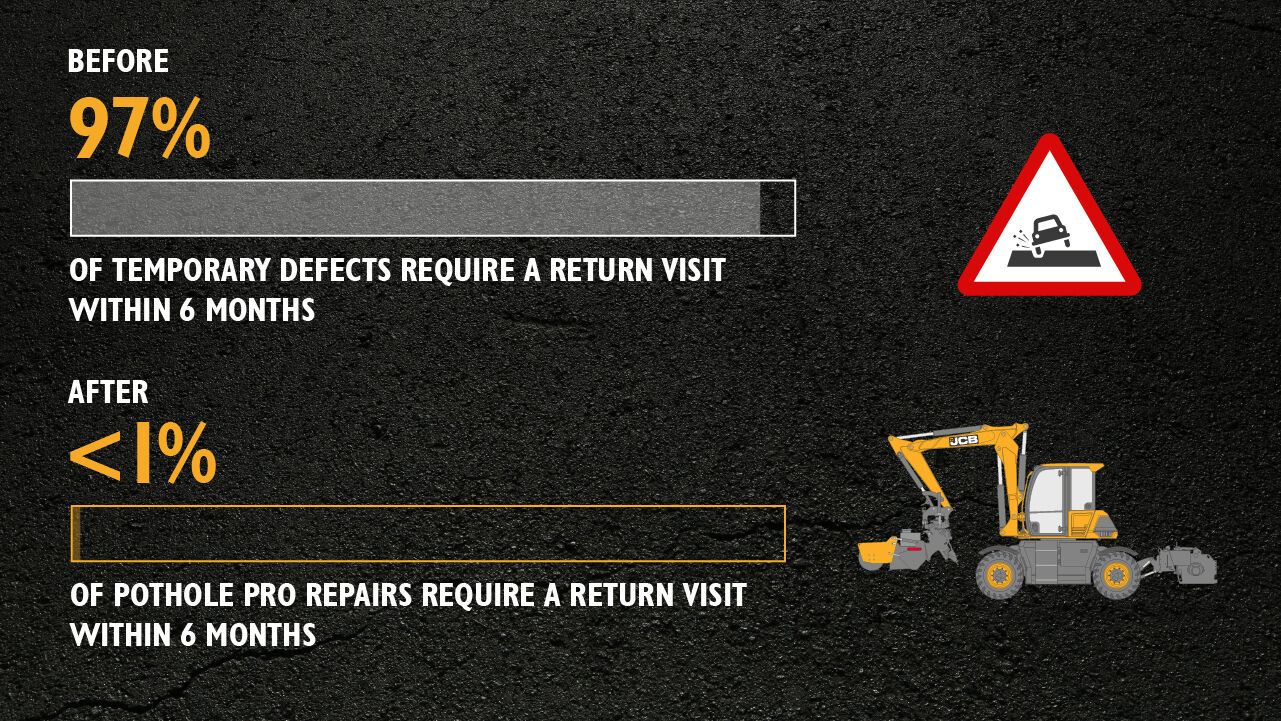08 July 2024
Dangers, prevention and repair: everything you need to know about fixing potholes
At best an annoyance and at worst a serious danger, potholes are one of the most complained-about issues among constituents.
But last year, there was finally some good news for road users regarding the “scourge of potholes” (a direct quote from Rishi Sunak.) £8.3 billion has been pledged to resurfacing more than 5,000 miles of roads across the UK. With this funding now available to local authorities, we’re explaining everything you need to know about how to fix potholes: the dangers, prevention techniques and why you can trust JCB machinery for permanent results when repairing potholes.
How potholes are formed
We can all be quick to blame poor road maintenance as the cause of potholes – and while this is a factor, it’s not the main reason for the problem. There are three key elements that lead to the formation of potholes:
Cracks on the road surface: the result of aging asphalt, poor drainage utility works or thermal movements.
Water: rain enters the cracks then saturates and softens the soil below. And when water freezes in the cracks, it opens them up even further to accelerate the process.
Traffic: the weight of vehicles breaks up the fractured surface, throwing out blocks of asphalt which initiates then deepens the potholes.
These key causes explain why the UK has more potholes than many other European countries. In comparison, our roads carry higher traffic loads and have a higher density of utilities buried underneath them. Additionally, our winter temperatures tend to remain above freezing but with frequent short dips below – exacerbating the freeze-thaw cycle that makes potholes worse. Combine all this with maintenance budget issues, and it’s clear to see why they’ve become such a big issue.
The dangers of potholes
Before we look at how to repair potholes in roads, a reminder of why it’s so important they’re dealt with. Firstly, there’s the damage they can cause to cars. Figures from the AA show that call-outs to pothole-related breakdowns are at near-record levels: more than
450,000 in 2023, with common problems including broken suspension sprints, distorted wheels and damage to shock absorbers.
But beyond cost, there’s the more serious concern of the safety of road users. According to statistics from the UK Department for Transportation, there were
7,847 casualties between 2022 and 2021 where the primary cause was a poor or defective road surface. This includes
452 cyclists and
725 motorists who were killed or seriously injured – and on track to rise within coming years.
Looking at the issue economically, there’s concerns surrounding costs too. Left untreated, potholes will continue to get worse – leading to bigger, more expensive roadworks that need to be funded. And if a repair isn’t completed to the highest standard, the pothole will only reappear in a matter of weeks or months, meaning repeat costs and wasted resources.
The challenges of fixing potholes
So the big question - how can we combat the threats potholes pose? Before work can even begin, there are several challenges local authorities and councils have to deal with. Historically, one of the biggest has been making funding available for resurfacing, but the recent announcement means there’s a real opportunity for improvement. This unprecedented £8.3 billion investment in UK roads has already begun with £150 million made available last financial year, and another £150 million to follow for this financial year. The funding will continue to be allocated through to 2034, and is enough to resurface more than 5,000 miles of roads across the North West, North East, Yorkshire and the Humber, the West and East Midlands, the East, South East, South West and London.
The repair of potholes depends on the size of the crack or hole - but it most often involves filling the hole in with either cold or hot mix asphalt.
There are a number of challenges involved with this, including:
Cooling materials: hot asphalt cools quickly, so by the time it's loaded in the truck and placed in the hole, it's no longer at optimum temperature. This makes it harder to work with and often leads to potholes re-appearing sooner rather than later.
Ergonomics: the asphalt often has to be shovelled from above shoulder height at awkward angles, which makes work inefficient and causes stress on worker's bodies.
Poor quality asphalt: cheaper varieties don't create a strong enough bond with the road surface, meaning the pothole can return in as little as a few weeks. Quality asphalt has a uniform black colour, smooth and consistent texture and strong adhesion with the aggregate.
The road surface: different types of road may require different materials, so if you're considering how to repair potholes in a gravel driveway, this may need additional work.

The JCB Pothole Pro: an award-winning solution
Given these challenges, it’s clear that the equipment you use is key to permanently repairing potholes – and authorities can rely on the JCB Pothole Pro to deliver the best results. This award-winning machine is specifically designed as a unique 3-in-1 solution, fitted with 3 dedicated attachments to cut, crop and clean the area before the asphalt is added. This creates optimum conditions for the asphalt to make that permanent bond, with no need for additional equipment or extra manpower. And with performance stats like these, it’s proven for its efficiency:
- Repairs a typical pothole in just 8 minutes.
- Capable of covering up to 250 square metres a day.
- Repair costs of just £29.28 per square metre.
- Less than 1% of potholes need to be revisited after 6 months when using the Pothole Pro, compared to 97% when using temporary repair methods.

Just click here to learn more about the JCB Pothole Pro and download the brochure – or take a look at it in action on BBC Breakfast. You can also find out more about our partnership with Dawson Group, making more than 60 Pothole Pro machines available for rent or contract hire across the UK. It’s the ideal solution for city councils looking to complete repairs without long-term investment in a machine.
As the saying goes, prevention is better than cure – and there are lots of techniques like surface cleaning, crack sealing and surface treatment application that can help prevent potholes from forming. And by reporting potholes and staying informed about local initiatives, everyone can play their part in creating safer and more resilient roads.
With the current shape of the UK roads, prevention can only take us so far – so repairs will be essential to enhancing our road infrastructure. As the funding continues to be made available, JCB will be on-hand to work with city councils across the UK and provide a permanent solution to one of road users’ biggest problems.